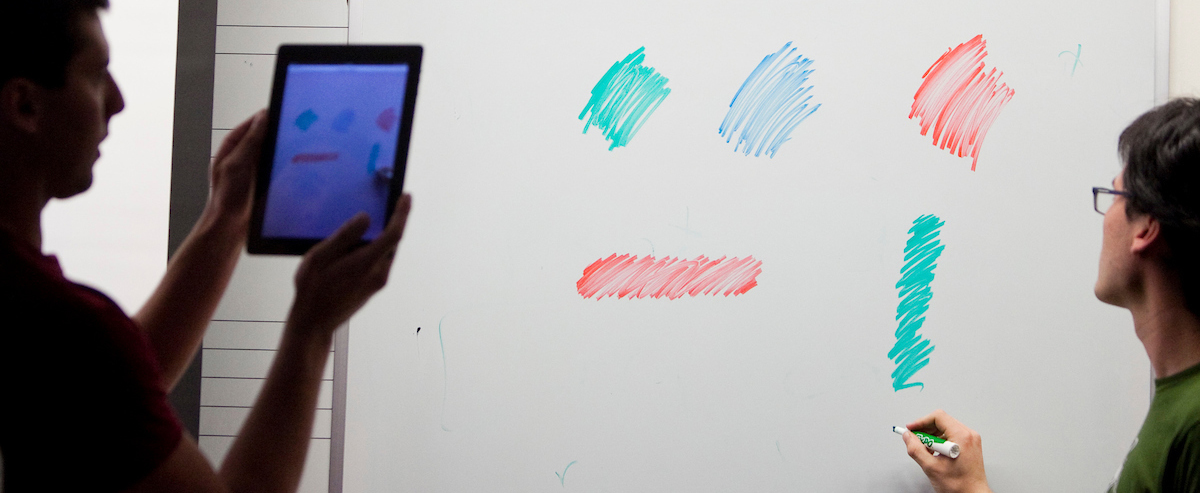Index of Teaching Technologies

Over the last three decades, computer-based technologies for teaching have become ubiquitous, and are now woven into every facet of course design, teaching, assessment, and evaluation. Tufts supports the meaningful integration of these technologies into academic programs and courses.
Throughout the pages here on the Teaching@Tufts website you’ll find recommendations for various teaching technologies. You can also browse this A-to-Z index, and you are welcome to get additional information and support about teaching with technology from Tufts Educational Technology Services (ETS).
Active Learning Technologies
Active learning comes from students’ active participation in classroom activities, both mentally and physically, which enables them to construct their own learning —
- What is active learning? (U of Minnesota)
- Some model experiments: Technology-Enabled Active Learning (MIT)
Assessment Technologies
Tufts provisions a range of assessment technologies for use in the classroom —
- Poll Everywhere, for frequent low-stake assessment, and real-time student engagement in the classroom
- Quizzes and Grading tools in Canvas for assessments built into the learning management system
- Tufts Qualtrics Surveys to collect data on student learning and feedback on your teaching
- ePortfolios can be built in Canvas or Box, and allow students and instructors to present a collection of learning evidence and reflection on progress
- Examplify by ExamSoft is used by Tufts’ health-science schools for paperless formal exams
Course Administration and Management
- Tufts provides the Canvas learning management system (LMS) to facilitate teaching, learning, and assessment of courses
- We offer a range of Canvas trainings and user guides to support its use
- While Tufts’ health-sciences campuses switch from TUSK to Canvas, TUSK resources remain available
- Box is a versatile content creation and storage tool available to all Tufts members. Box is especially useful for highly collaborative projects within a course
Discussion Technologies
Discussion technologies can be used to encourage student interaction both in-class and online. Discussion assignments can be a simple check-in with students, or can be more structured, requiring reflective writing or peer-to-peer feedback. In online courses, discussion serves a major conduit for student interactions with instructors and peers.
- The Discussions tool in Canvas allows instructors to post discussion topics, generate threaded responses, and oversee student discussion from inside the learning management system
- Poll Everywhere is a classroom response system which can be used to promote discussion
- VoiceThread provides an online social environment for students to interact with their instructor and classmates using digital audio and video. Students can post text comments, record audio clips, or upload videos as part of a discussion. Contact Tufts’ Educational Technology Services (ETS) to learn more and get an instructor account.
- With WordPress, a robust website-building tool, students can create individual blogs and share them with classmates. Instructors can also create a single, class-wide blog and invite students to author and comment on posts. Visit Tufts’ WordPress site for help getting started.
- WebEx, the university’s video-conferencing tool, has a built-in chat feature. An instructor can share lecture slides to students’ devices via WebEx, and instructors and students can use their webcam, microphone, and chat, to communicate in real time.
- Piazza is an online forum tool designed for active discussion. Students can post questions about class content (anonymously, if they choose) and classmates can collaborate to write answers in response.
Experiential/Service Learning/Fieldwork Technologies
Experiential learning, service learning, and field work all engage students in the world outside the classroom, to expand their experience and enrich their learning
- Experiential learning defined (UT Austin)
- Online portfolios or e-portfolis are “a purposeful collection of sample student work, demonstrations, and artifacts that showcase student’s learning progression, achievement, and evidence of what students can do” (UC Berkeley)
- Technology-driven Service Learning: The Instructor’s Role and the Student’s Experience (EDUCAUSE)
- Digital ethnography, a social science research “method for representing real-life cultures through storytelling in digital media” Michael Wesch, a leading expert (Kansas State) (UTexas Press)
- Technology outside the classroom (Vanderbilt)
- For help with technologies which support experiential and service learning contact Tufts’ Educational Technology Services (ETS)
Evaluation Technologies
Technologies for recording teaching sessions can facilitate faculty evaluating their own teaching. As an example this series of Virtual Classroom Visits offer Tufts faculty insights into how they elicit students’ ideas and questions, interpret and respond to students’ thinking, and encourage disciplinary reasoning practices.
Group/Team Technologies
Instructors can organize and conduct group work to enhance student interaction using tools specifically designed with group features. Most of these tools offer multiple ways to form groups —
- Use Groups in Canvas to coordinate learning activities such as assignments, discussions, and quizzes for groups of students; especially useful for a large class
- Poll Everywhere can help you and streamline group teaching models such as peer instruction or team-based learning
- Piazza can enable agile group interaction and forums among students, which can be useful for small group teaching, lab/recitation, and project-based learning
- Wikis allow for collaborative writing and documentation of group work
Inclusive Technologies
Educational technologies can support inclusive teaching. With these technologies and a range of media types you can create more flexible and alternative learning environments for learners —
- Universal Design for Learning (UDL), a framework to improve and optimize teaching and learning for all people
- Resources for implementing UDL with technology include: flexible multimedia, accessible educational materials and web-based presentation
- Online course design can be approached as a way to meet students diverse needs (Faculty Focus)
- Tufts’ Student Accessibility Services provides information, services, and resources
Lecture Capture Technologies
Lecture capture tools allow you to create recordings of your lecture, including audio, video, and presentation materials on the screen, and share them later with your students —
- Educational Technology Services faculty guide, Video Tools for Teaching, can help you decide which lecture capture tool is right for you
